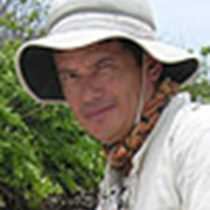Bartolomé and Rabida Islands
Bartolomé and Rabida Islands are two of best places to observe the geology of the Galápagos Islands. Their colorful beaches and landscapes are unique in the archipelago.
Early in the morning we headed to Bartolomé aboard Zodiacs. In the distance we saw Pinnacle Rock and the golden beaches that are the most striking features of the island. Meanwhile in the transparent water we saw a flock of penguins swim around of us chasing small black striped salemas. When we arrived at the island, the landing area was full of Sally Lightfoot crabs and marine iguanas. We started walking along the boardwalk trail with its 372 steps that led to the summit of the island. We observed as lava lizards tried to eat their breakfast, catching small flies and grasshoppers, and how the insects fed on plants, and we saw how, even in that barren place, nature’s food chain is on display.
We could read the history of solidified lava flows over this island, and it was possible to observe the direction of the lava with its different textures and colors. It looks incredibly similar to photos of the surface of Mars, the red planet.
After breakfast we returned to Bartolomé, but this time we were there to explore the underwater world, snorkeling from the golden beach around Pinnacle Rock. Water was transparent allowing us to observe many species of fish, such as sergeant major, salemas, barber-fish and tiger snake eel. Probably the best sighting was a Galápagos shark and a white-tipped reef shark swimming along the bottom. I was concentrated observing these beautiful creatures, when I heard very excited people calling me, because just in front of us, a flock of penguins swam very fast like torpedoes around of us. It was an unforgettable experience.
In the afternoon, as soon we dropped anchor at Rabida Island, we began our outings snorkeling and kayaking along the coast. We observed sea turtles, fishing blue-footed boobies and curious sea lions swimming with us, inviting us to play with them. Afterwards, we landed on the red beach. High concentration of rusted iron lends its color to the whole island. We walked few feet behind the beach when another surprise was waiting for us. On the brackish lagoon behind, two flamingos fed anxiously. For many years this beautiful bird had abandoned Rabida, and probably after the last tsunami occurred in Japan three months ago in which seawater flooded the lagoon, crustaceans were reintroduced here, which is the source of food of the flamingos.
As we hiked along the inland trail, we observed another special bird; it was a juvenile Galápagos hawk observing us from the branches of a nearby tree. Our guests could take many pictures and enjoy its magnificence. Our adventure continued along the trail where we observed the green vegetation and many birds such as finches, mockingbirds and yellow warblers, while behind, the mountains little by little were covered with black clouds as if announcing the end of this beautiful day in this paradise called Galápagos.




